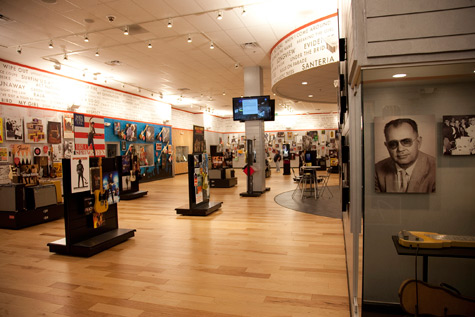 |
 |
|
  |
OCT. 11 I FENDER I VENUES Fender fanatics from around the world can now get a firsthand look at the company's history and manufacturing processes. On Sept. 15, the Scottsdale, Ariz.-based supplier inaugurated the Fender Visitor Center, an 8,600-square-foot celebration of its legacy. Located in Corona, Calif., the center sits adjacent to the company's U.S. manufacturing facilities, which visitors can now tour for free as part of the Visitor Center experience. Inside the building, guests are treated to interactive displays, historic instruments and the Fender Hall of Fame, as well as a retail shop where visitors can design and purchase their own instruments. And according to Fender CEO Larry Thomas, the company built the Visitor Center as much for its employees as it did Fender enthusiasts. He told this and more to Music Inc. Editor Zach Phillips in late September. An edited transcript of the conversation: Phillips: What is the purpose of the center? Thomas: I spent a long time walking through the Corona factory, and I was just amazed by what they actually make there. They take big sheets of plastic, and they stamp out pickguards on machines. They drill it out, and they put the foil on the back for the grounding. They actually stamp out the plates that they make the bridges from for Telecasters and Stratocasters. So I'm seeing all these processes, and it's just blowing me away. I thought with this Visitor Center, I can honor the employees in the factory by showing all the stuff that we make. I needed to find a way, frankly, to return the soul of Fender to Corona, if you will. I needed to find a way to make the factory the center of the company again. And Fender makes hundreds of products. Most music stores only carry a fraction of these models. So I thought, "Wouldn't it be great if you could go to one place, and you could actually see each of these instruments and hold them and play them and decide for yourself whether this is the guitar for you?" Phillips: Along with the museum, what's a standout attraction at the Visitor Center? Thomas: We have a wood room. It smells like cedar when you walk in. We have all these painted bodies sitting there. And a guy can choose a neck because we have a whole rack of necks. So you, as a guitar player, can grab a neck that feels good, and you can walk over and pick out a body. And you can basically put a guitar together on a bench. You can pick up a pickguard assembly — we have them in all different colors. You can order a guitar right there That guitar, unlike a custom shop guitar, is made on the factory floor. It's our regular production stuff. But if you can't afford a custom shop guitar, you can get one of our production necks, which to me are absolutely just as good. Phillips: What's your message to local Fender retailers who say, "They're selling guitars at the Visitor Center and taking away my business?" Thomas: Let's say you're a dealer in Los Angeles. You can run a contest in your store, and you can offer the winner of that contest a trip to the Fender Visitor Center. You can send your salesman down with them, and when they build that customized guitar, it's going to be priced so that you can make a margin. We are selling direct there. You can buy T-shirts and other stuff. And frankly, I'm hoping that in the next two years, you'll have a brochure in all the hotels up and down California. So if you come in from Iowa and you go through the factory tour because you're a Fender fanatic and you decide to custom-build a guitar, we'll sell you that guitar direct, too. But I think that the messaging of the brand is going to enrich the relationship the dealers have with the company. We didn't open [the center] to sell guitars. Phillips: You already have a lot of dealers to do that. Thomas: That's right. But on the other hand, we do have a need to control our brand and the messaging of the brand. Because I could never get the dealers to brand the products fully the way we want to as a manufacturer. This gives us the opportunity to do that. If you look at Apple or Nike or some of these other companies that have done this, they have all had to do something in order to convey their message to the end user. And in the end, I think it's been something that's helped the brand. MI
|
|

